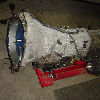SethChr16
New Member
- Joined
- November 3, 2006
- Messages
- 4
- Reaction score
- 0
- City, State
- Omaha, NE
- Year, Model & Trim Level
- 98 XLT 4.0 SOHC w/ VIS
My temp gauge is reading absolutely nothing when the truck is on. Getting very good heat so not a thermostat issue. Here is the part that is confusing me, my temp sending unit has 2 wires on the connector, one is red w/ white tracer and the other is black w/ white tracer. With the key on, if I ground the R/w wire the gauge pegs out full hot so I know the gauge works. Grounding the B/w wire does nothing. If I probe the B/w wire and check for continuity I get continuity to both positive and negative. What is the extra B/w wire for and why continuity to both pos and neg?










